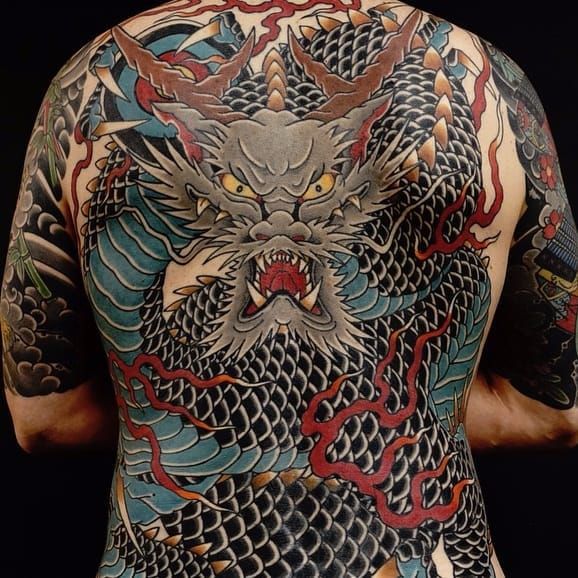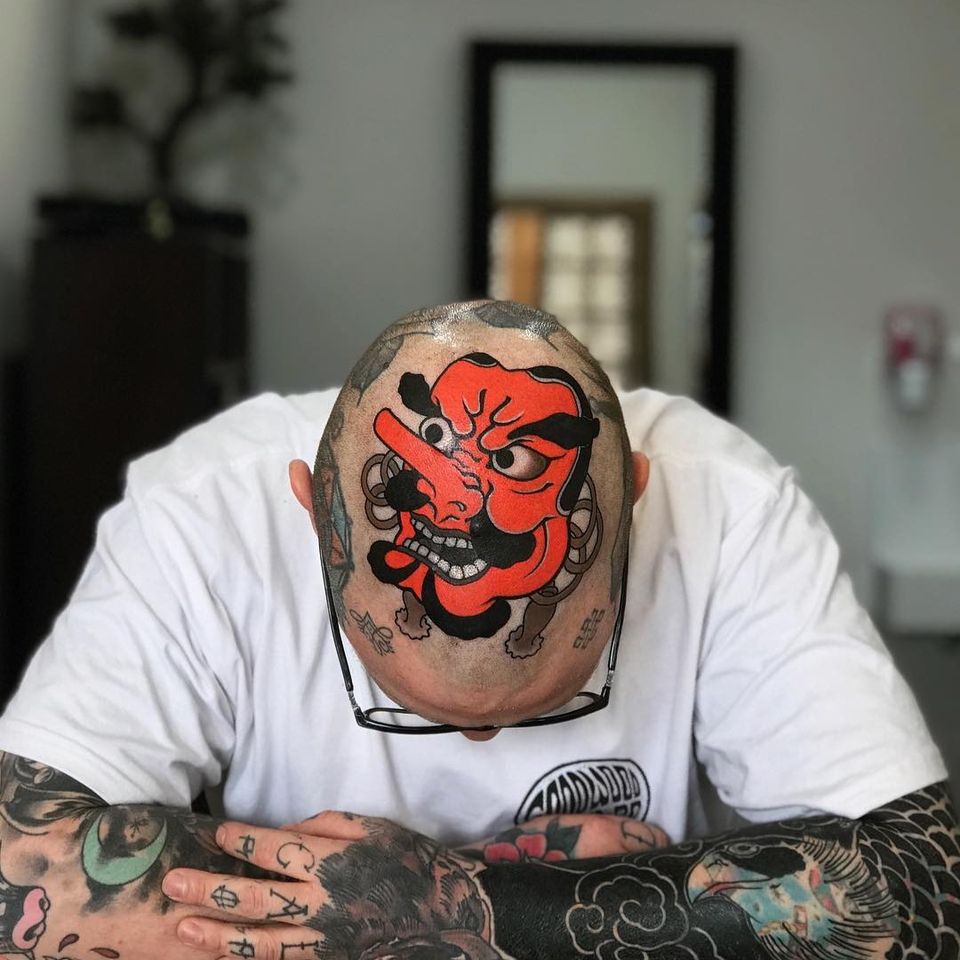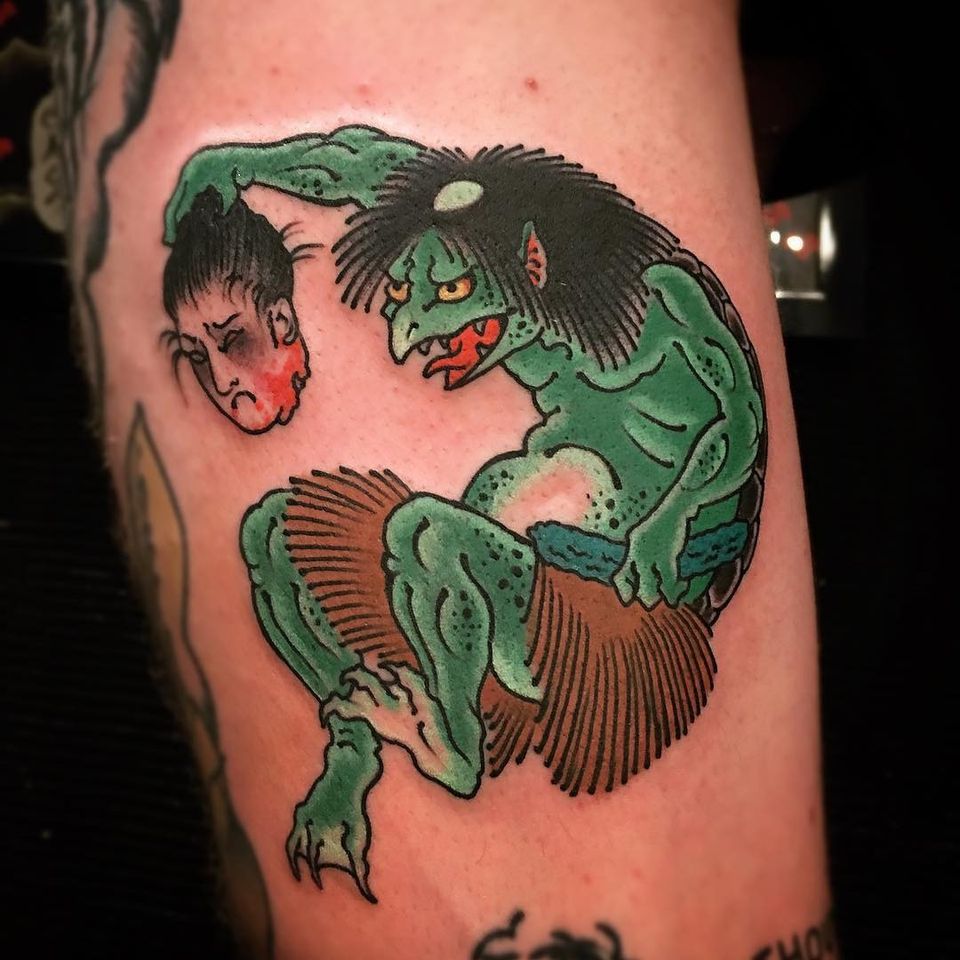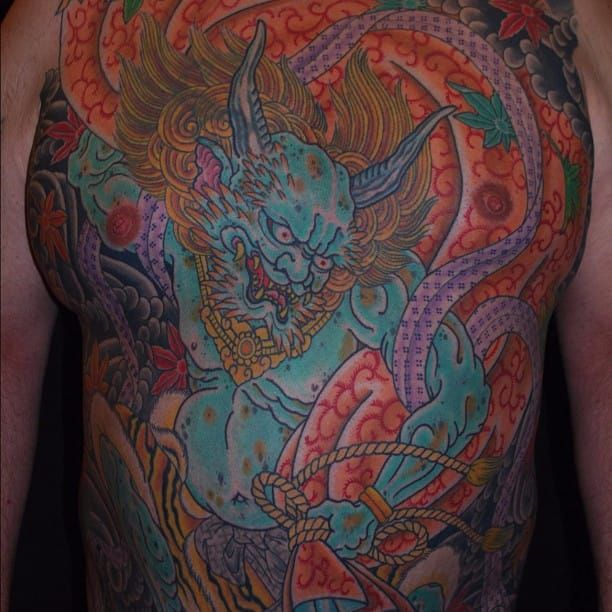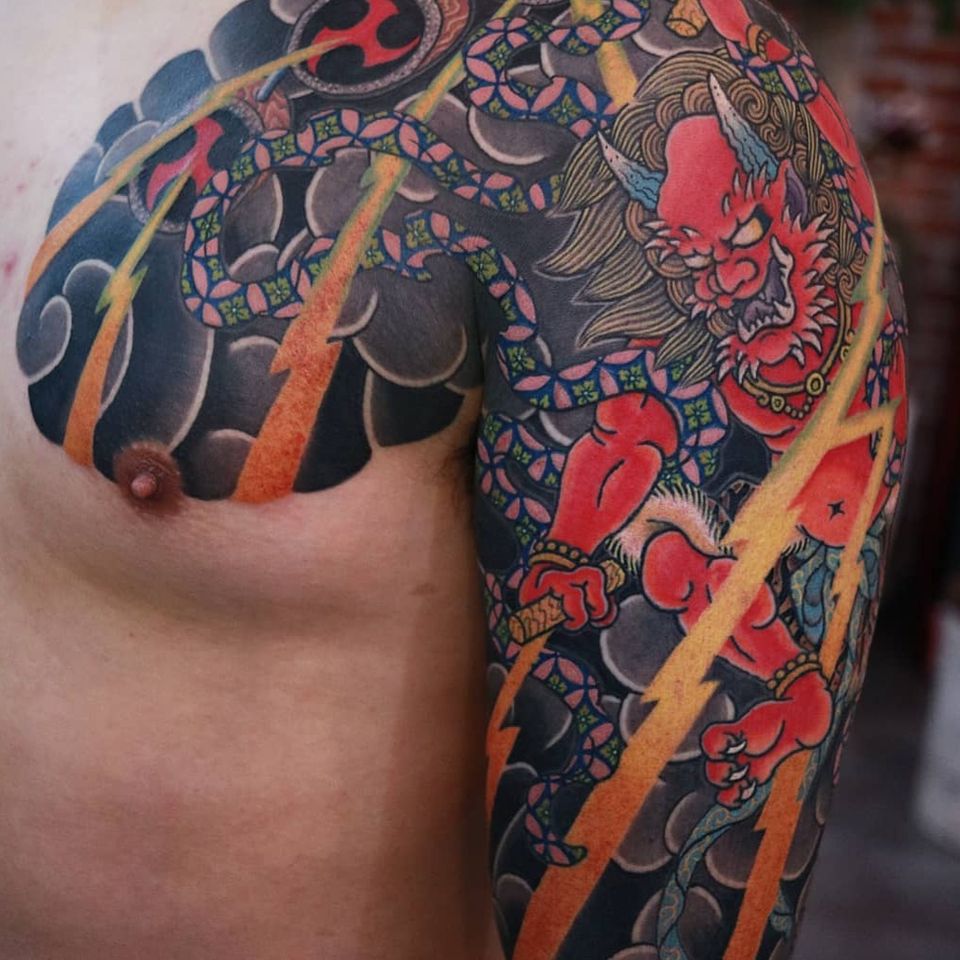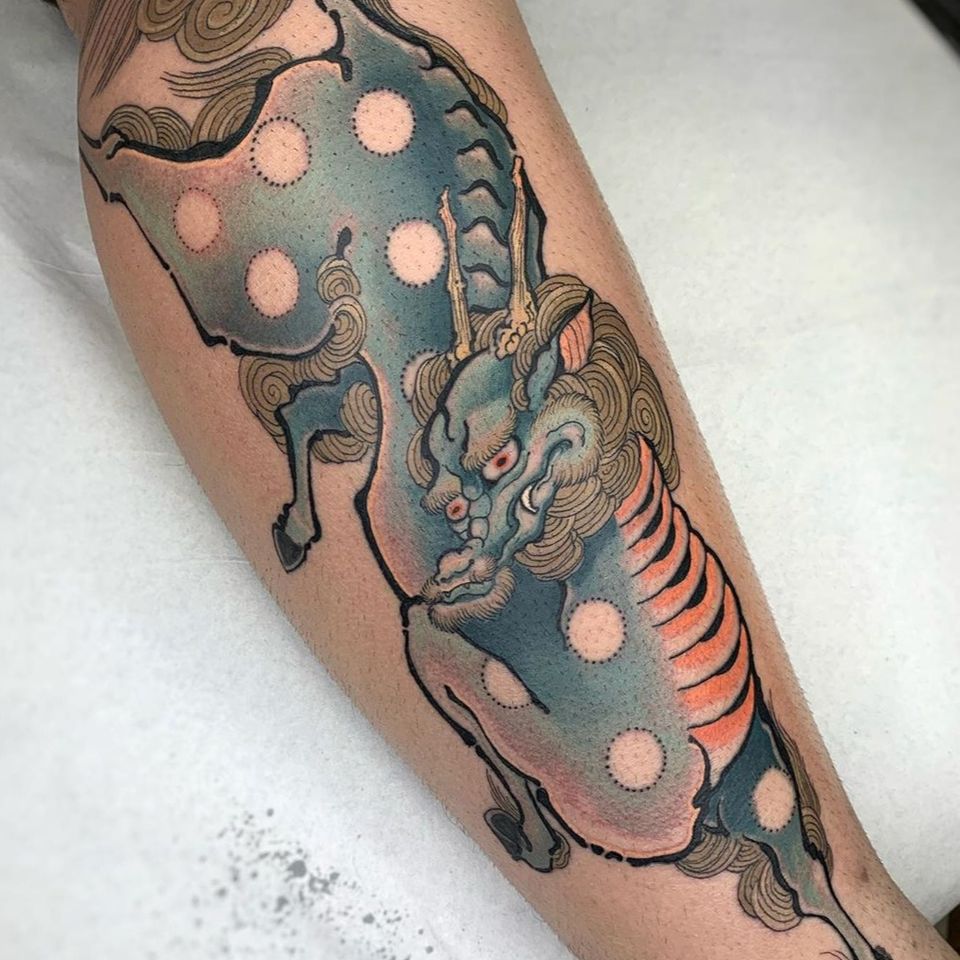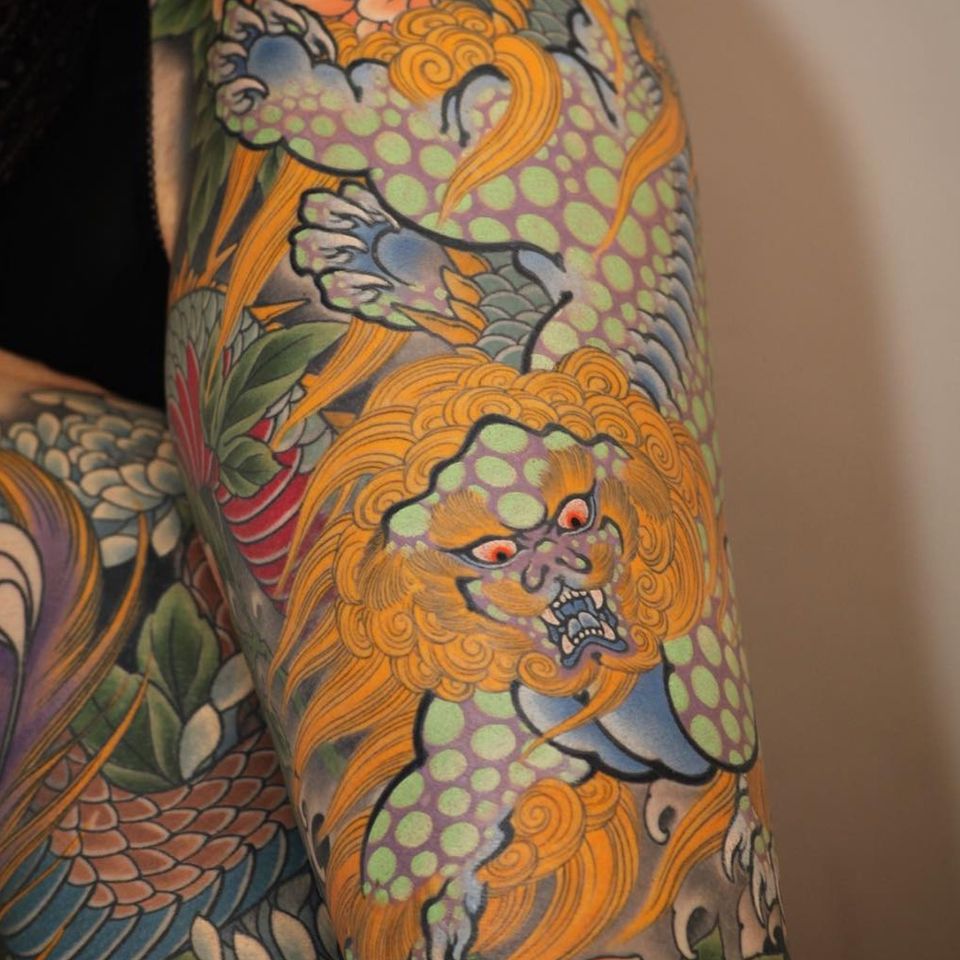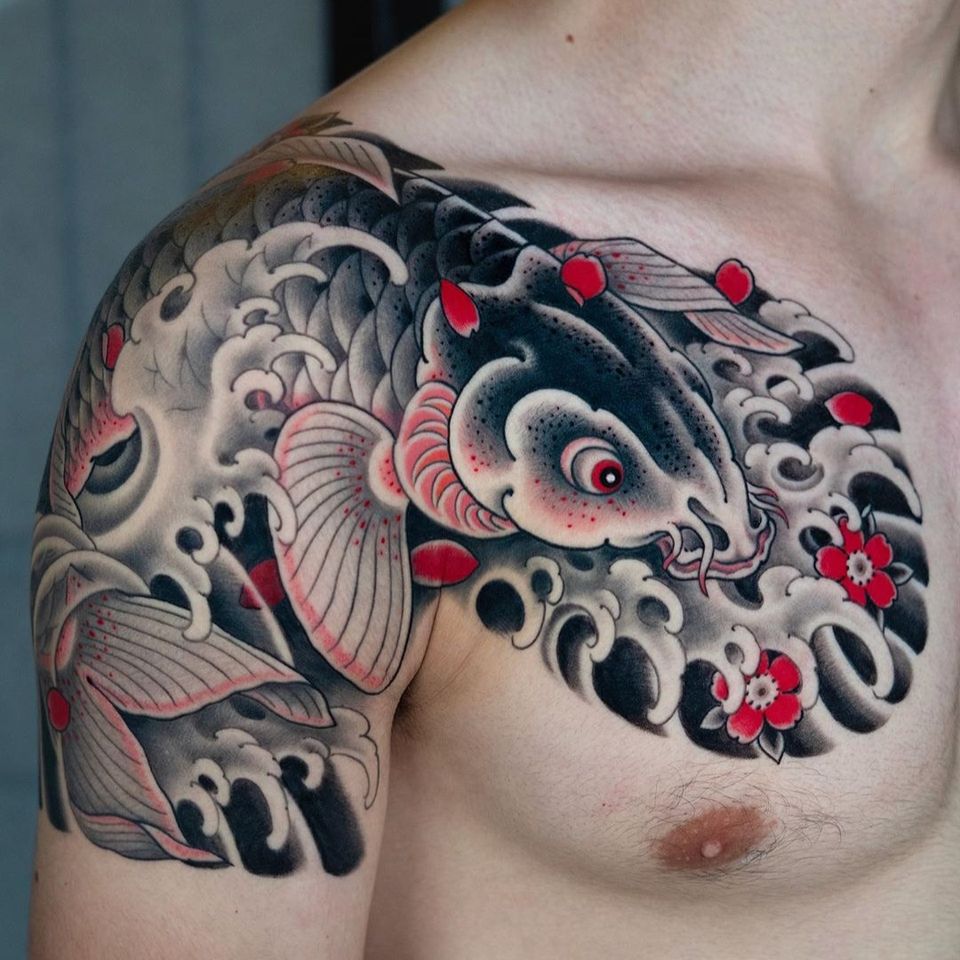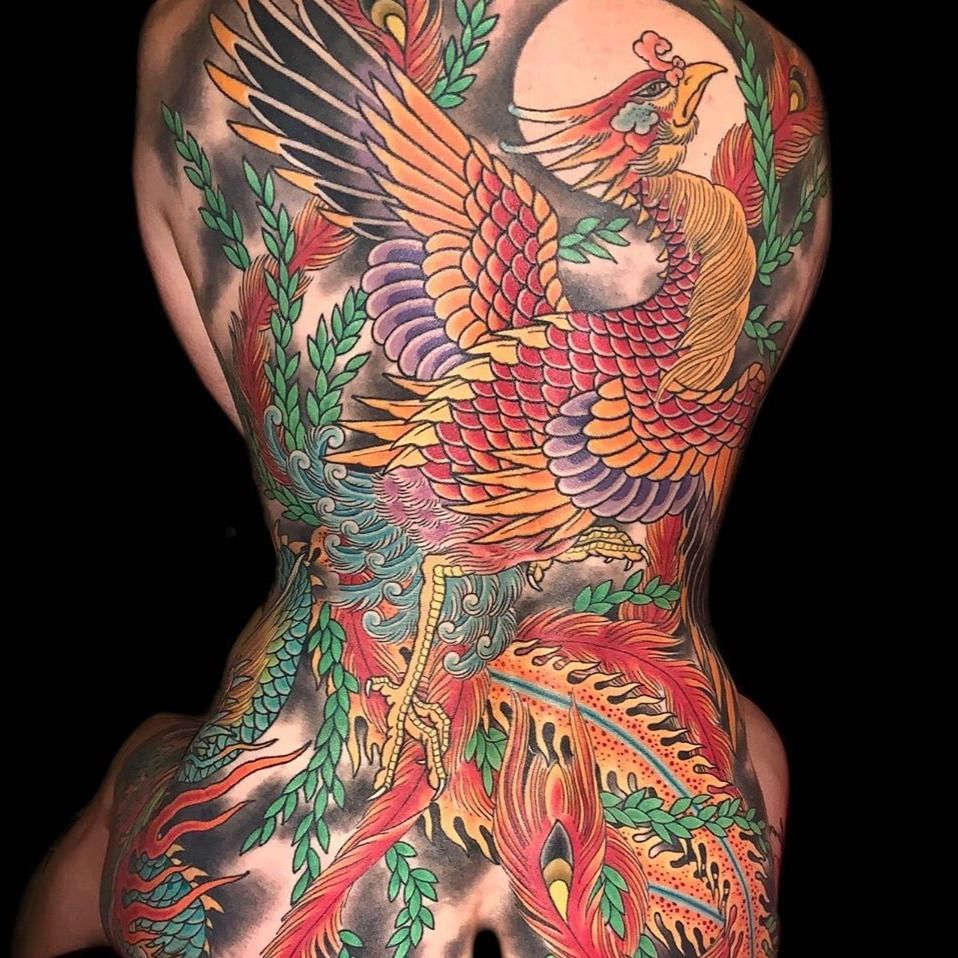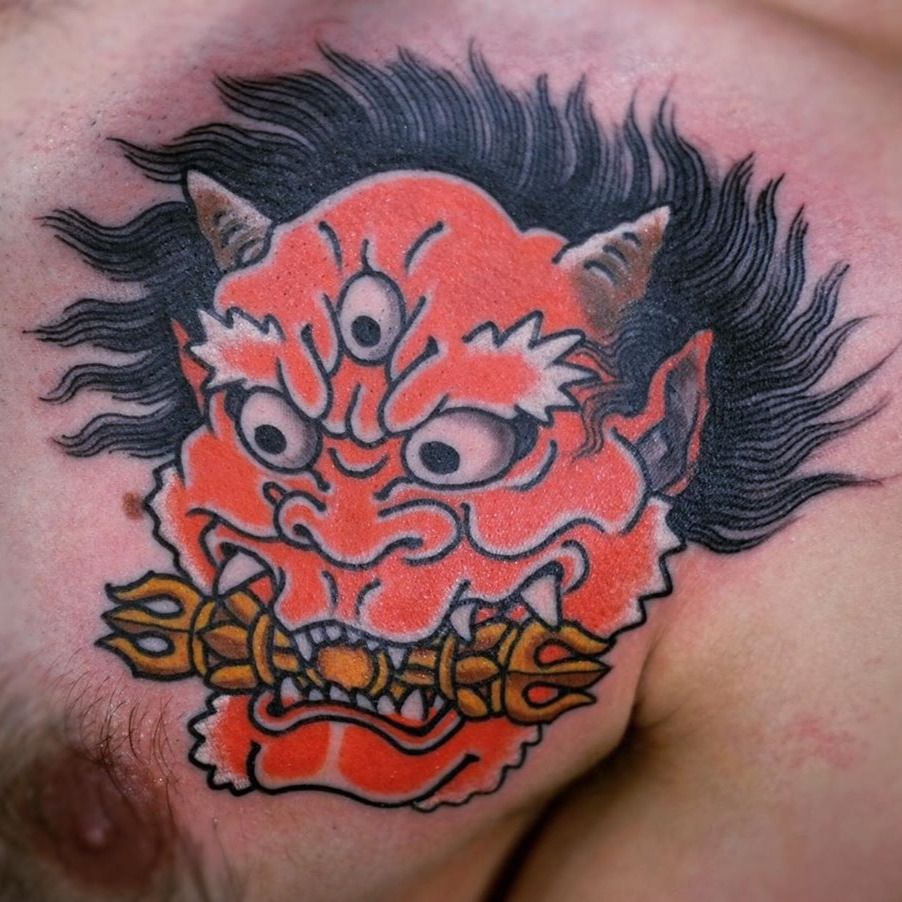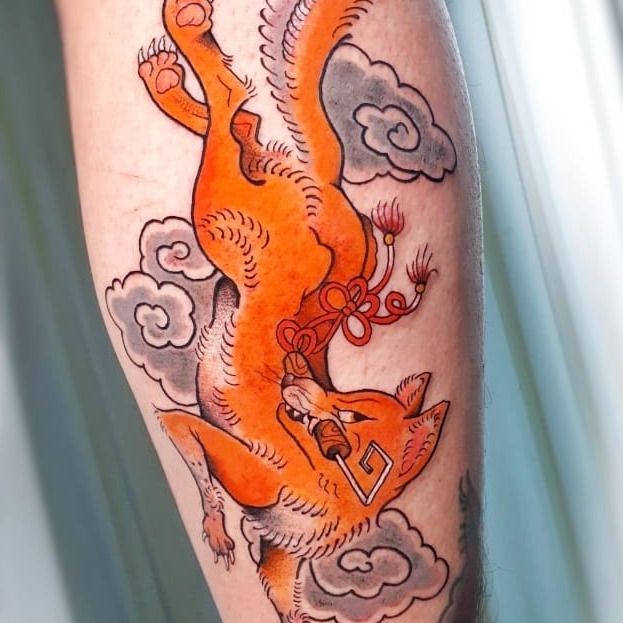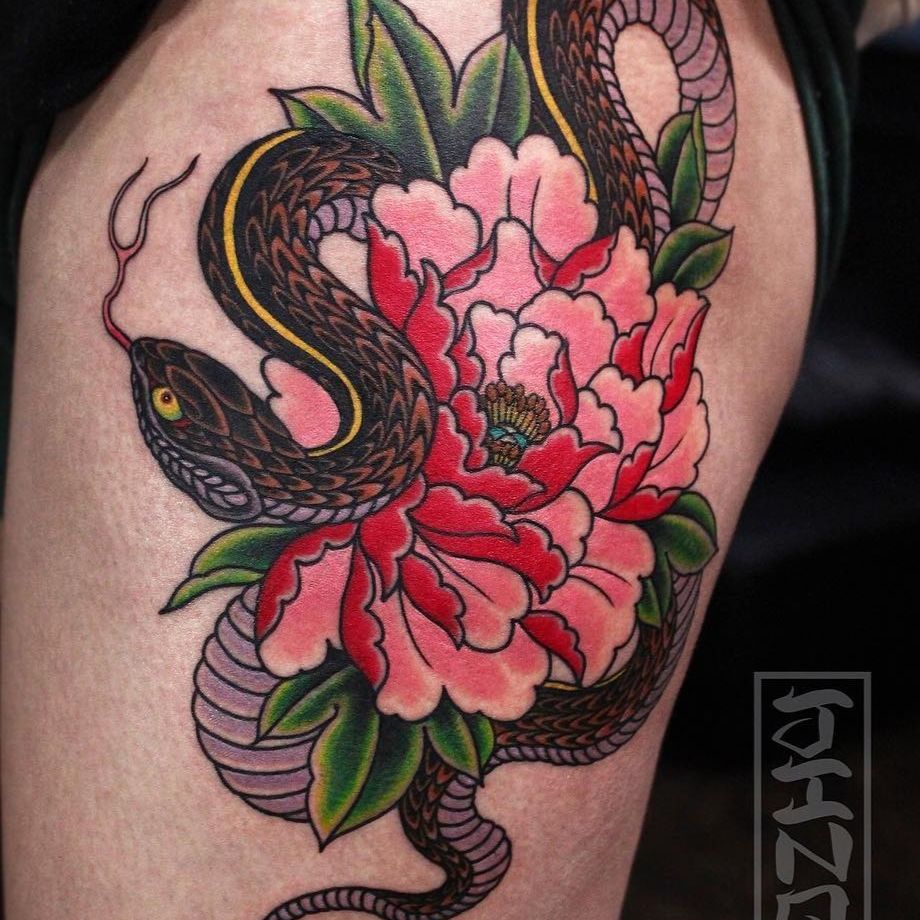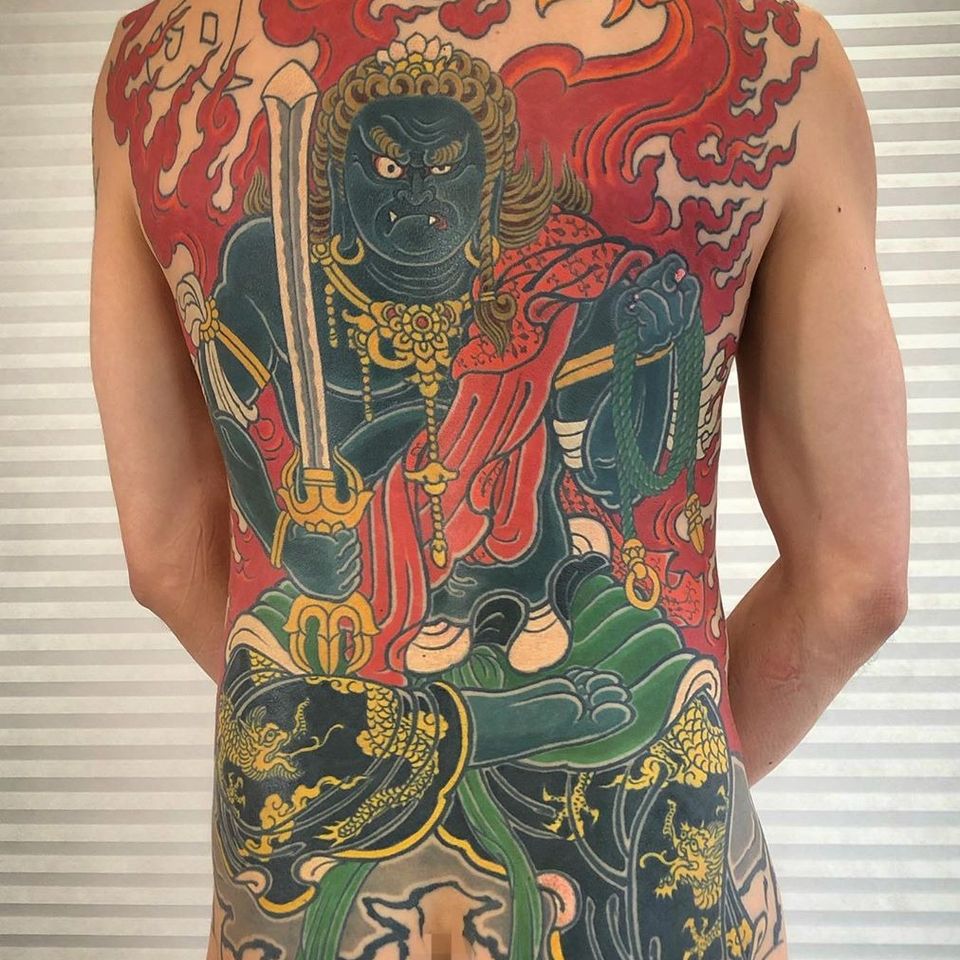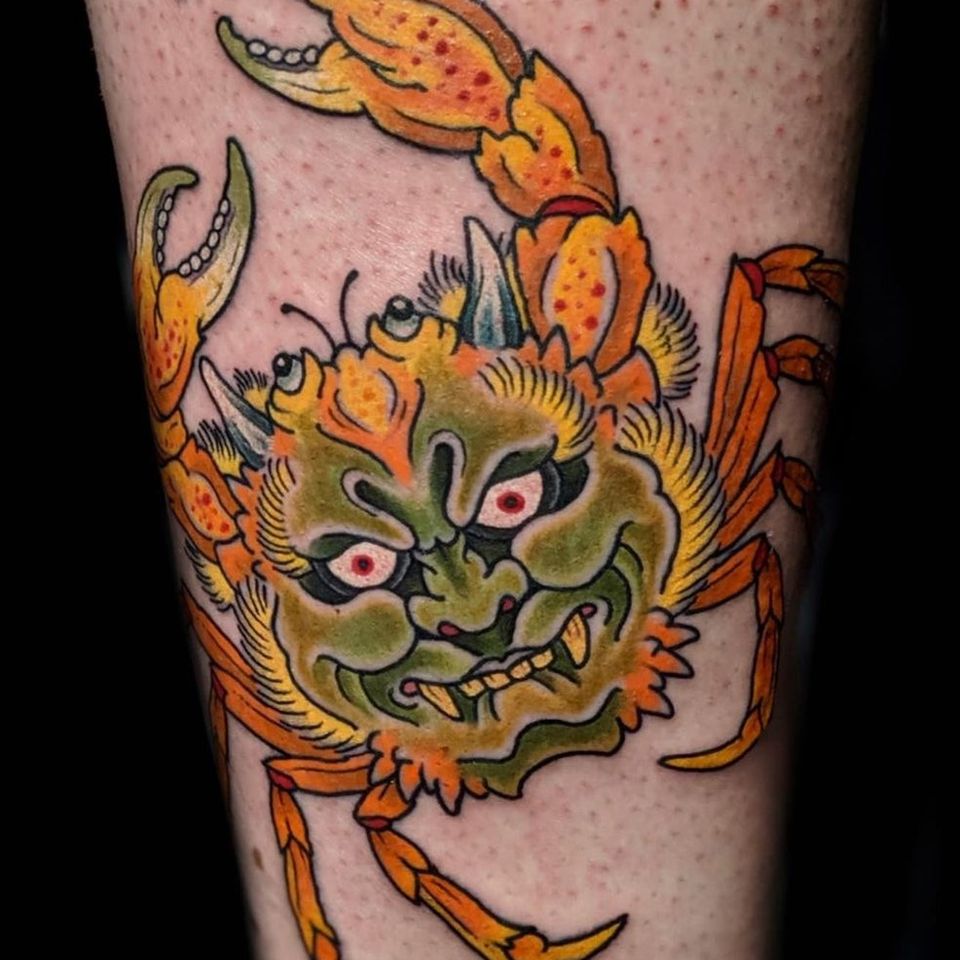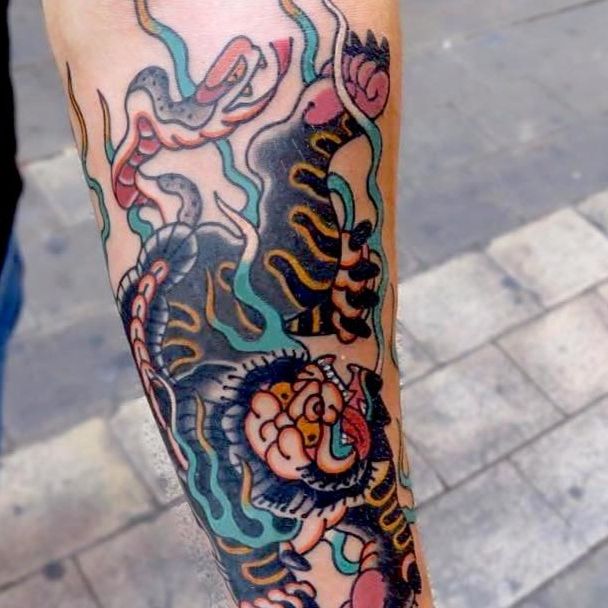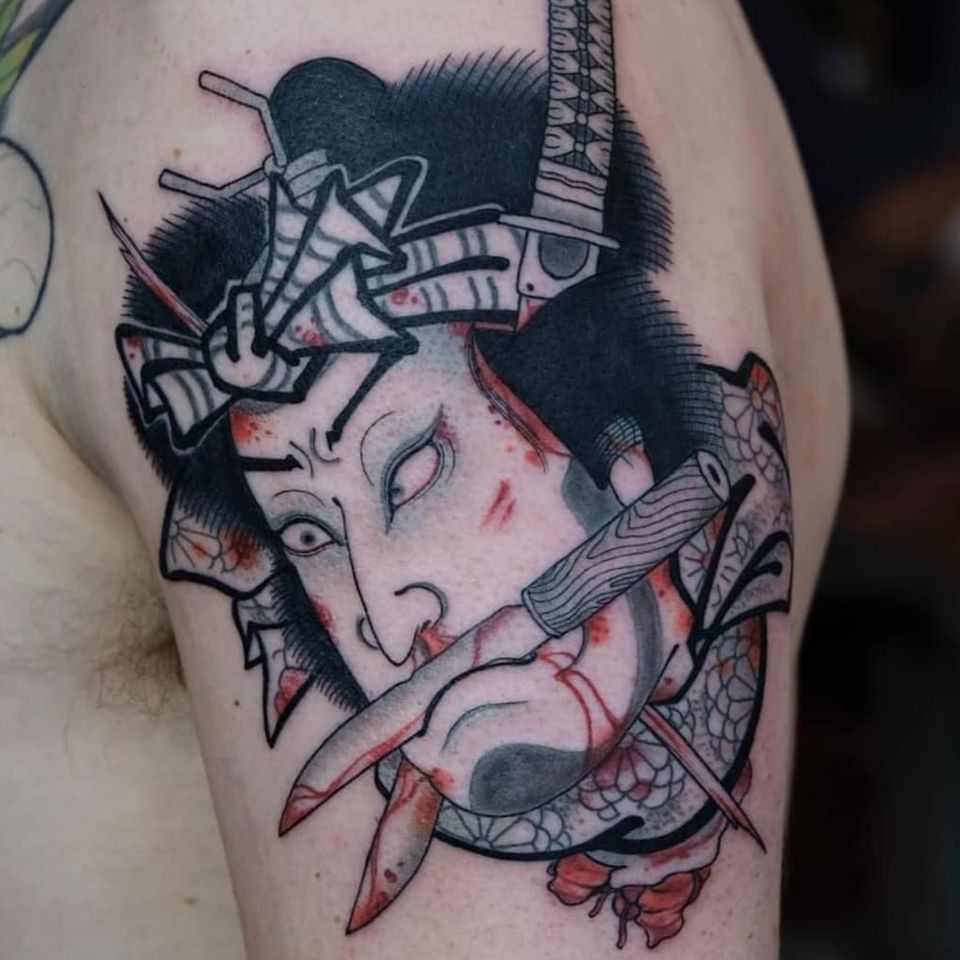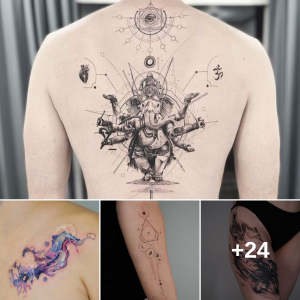A mainstay of the tattoo community and culture, Japanese tattoos are culturally influential and illustrate a bevy of beautiful, terrifying, and downright mystifying creatures. Since there are so many characters within Japanese mythology and iconography, we figured we’d give you a list of the 50 top Japanese tattoo design motifs out there. Of course, there are literally thousands more but we hope this will be a primer for those of you are who interested in knowing more about the origins, characteristics, and meaning behind some of your favorite tattoo art.
1. Ryu Tattoo aka Japanese Dragon Tattoo
Arguably the most recognizable creature in Japanese iconography is the Dragon. Ryu are seen as a symbol of profound blessing, wisdom, and strength — due to their ability to manipulate the elements for the benefit of the people. Dragons tend to differ from one another as they are said to take on the characteristics of many creatures — typically depending on the animals it will encounter on its journey. His head is usually that of a camel, with the neck and belly of a snake, the scales of a koi fish, the talons of a hawk, chicken, or eagle, and the horns of a stag.
2. Tengu Tattoo
Tengu are a form of yōkai (supernatural creatures or ghosts). They are generally associated with themes of destruction and war. Though most commonly depicted as ‘humanoid’ nowadays, at one point, they were thought to take the form of birds of prey, hence the demonic creatures’ long noses which evolved from their predecessors’ beaks. Tengu are often illustrated as looking wrathful, and are frequently colored red to draw out their militant symbolism.
3. Kappa Tattoo aka Japanese Turtle Tattoo
The myth of this monstrous bipedal turtle derives from stories of giant salamanders who would reach out of shallow river beds to grab the unsuspecting with their powerful jaws. Kappa are notorious troublemakers and tricksters — who like peek up kimonos, kidnap children, and assault young females when they’re least expecting it (what the hell?).
The Kappa’s defining characteristic is a small cavity (or plate) of water located in its skull. When this cavity is dry he is powerless, so the answer to defeating a Kappa is to bow before him. Kappa apparently have a certain penchant for politeness — and will be compelled to bow back, thus spilling the water plate.
4. Fujin Tattoo
Fujin is commonly recognized as the Japanese deity of wind. He is most often depicted as an oni (demon-like) figure with skin of glowing green or blue and is believed to have powers similar to that of a wizard. The tapestry behind him is an enchanted object with which he controls air currents.
5. Raijin Tattoo
While Fujin is the god of wind, Raijin — his rival brother — is the Shinto deity of lightning and thunder. He is often depicted beating on drums to roar throughout the skies as thunderbolts fly off of his extremities. According to legend, the two brothers are combative in nature and stormy weather is a result of their endless squabbling.
6. Kirin Tattoo
The Kirin is another chimeral creature of Japanese folklore, and his rare appearance marks the passing of a sagely leader or ruler. Though its connotations of death seem like they would be sorrowful, this is not the case. The Kirin is seen as a good omen, signifying a better tomorrow achievable through the reflective process of mourning.
Kirin are traditionally rendered with the body of a deer, head of a dragon, the scales of a fish, hooves of a horse, mane of a lion, the tail of an ox, and a set of – or – single horn.
7. Baku Tattoo
According to legend, Baku are mythical creatures who aid in devouring nightmares. In Japan it is still common-place to see a Baku talisman near the bed, especially in a childs room. They are typically depicted with the head of an elephant, the claws of a tiger, the body of a bear, and the tail of an ox.
8. Karajishi Tattoo aka Foo Dog Tattoo
Often referred to as the “King of Beasts,” Karajishi or “guardian lions” are another popular image from traditional Japanese folklore. Statues of these lion-like mythological creatures have traditionally been placed at the entrances of palaces and temples to chase away evil spirits, hence them being well-known symbols of courage as well as guardianship.
9. Koi Tattoo aka Japanese Fish Tattoo
These fish are native to Japan and have been a part of Japanese artistic culture for a very long time. They are symbolic of numerous things, but given their extraordinary lifespans, they are most commonly associated with longevity, persistence, and overcoming the trails of life.
10. Hou-ou Tattoo aka Japanese Phoenix Tattoo
In Japan, hou-ou or the phoenix is symbolic of the imperial household. This mythical bird represents a number of other things, including fidelity, fire, justice, obedience, and the sun. Interestingly, this fiery bird is both a figure of harmony and disharmony, descending from heaven at times of peace and fleeing back to its astral abode when strife inhabits the land. Because of this, it is seen as an emblem of new eras, whether they be better times or worse. In Irezumi, they are generally depicted as having avian physiology with particularly long necks and scales like snakes along with peacock tail-feathers.
11. Oni Tattoo aka Japanese Demon Tattoo
Oni are the the demons and devils of Japanese art. They are typically depicted as being largely humanoid minus their claws, fangs, horns, and often vibrantly colored skin. Oni are frequently illustrated as wearing loin cloths and wielding weapons such as katanas and kanabō — massive, studded clubs. These little demons are the harbingers of disaster, disease, and other things that plague humanity.
12. Kitsune Tattoo aka Japanese Fox Tattoo
Kitsune are revered as extremely intelligent creatures, rumored to be immortal as well as magical. According to some accounts they continue aging until they grow old enough to become Tenko — celestial foxes — and ascend into the heavens. They purportedly can shoot lightning and fire from their mouths, fly, and psychically will dreams into the minds of others. In other legends, they even have been reported as being shapeshifters that turn into humans to either find love or drain the life-force from unsuspecting mates.
13. Hebi Tattoo aka Japanese Snake Tattoo
The hebi or snake have a wide range of symbolism in Japanese culture, but are often depicted as sharp-toothed guardian creatures that protect coveted riches and treasures. The snake can also symbolize rebirth, transformation, and the continual renewal of life.
14. Fudo Myoo Tattoo
Fudo Myoo, which in Japanese means “Wise King Acala,” is a Buddhist deity that was imported into Irezumi’s canon as the religion spread into the country. Though he has many interpretations, Fudo Myoo is generally seen as a wrathful protector, one who vanquishes spiritual impediments in order to help the faithful attain enlightenment. He is generally depicted as having an angry face with a wrinkled brow, pointy fangs, and squinted eyes. Traditionally, he holds numerous symbolic items, such as the three-pronged vajra sword and nooses.
15. Heikegani Tattoo aka Japanese Crab Tattoo
These disgruntled-looking crustaceans actually populate the beaches of Japan, and their backs really do look like scrunched-up angry faces. Though the Heikegani or “samurai crab” exists literally, their natural appearance has been borrowed into to Irezumi to figuratively represent the spirits of fallen warriors.
16. Nue Tattoo
This chimeric creature is straight out of The Tale of the Heike — the nearly a millennium-old Japanese epic poem. It is most commonly depicted as having an ape’s face, the body of a tiger, and a snake for a tail. In the text, it describes a mysterious cloud of black smoke and a haunting voice. After the arrival of this ominous figure, the emperor at the time, Nijō, becomes seriously ill. Since no medicinal or spiritual remedies have any effect on him, he and his advisers deem it a curse brought on by the supernatural figure of the Nue. Nijō commands his best archer, Minamoto no Yorimasa, to go slay the beast. The archer’s apprentice, Ino Haya, then takes one of his master’s arrows, hunts down the Nue, and kills it, saving the emperor in the process.
17. Namakubi Tattoos
Not only a reminder of the impermanence of this life but an homage to the many great warriors and samurai of Japan’s history, Namakubi tattoos are images of severed heads. Usually covered in spots of blood, other details can include daggers, rope, and arrows. These images have their roots in the history of feudal Japan when serious wars were being fought and many honorable rituals were in place including Seppuku, often called Hari Kari. Used as both a suicide ceremony and capital punishment, Seppuku involved self-disembowelment followed by beheading. Namakubi tattoos are a grisly reminder of honorable actions, respect, courage, and overcoming fear.
Read more: Heads Will Roll – Namakubi Tattoos
18. Sakura: Cherry Blossom Tattoos
The Japanese have an immense respect for the natural world and the cycle of life it represents. Cherry blossom tattoos are a perfect embodiment of this. The Japanese have a history of practicing Buddhism and embracing impermanence is a large part of that. These beautiful flowers bloom and then wither usually in the space of 14 days. Cherry blossom tattoos usually capture them at their fullest, but they are still symbolic of the short, yet sweet, time we spend on Earth.
